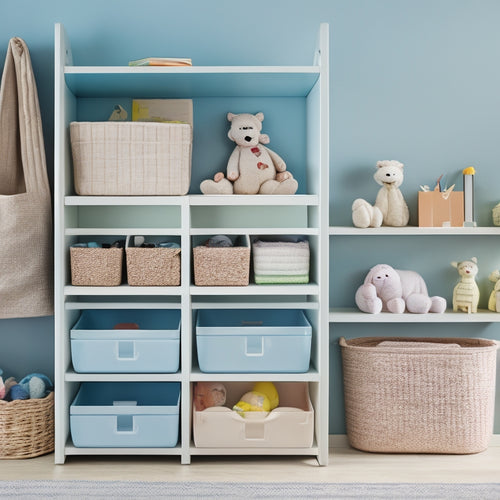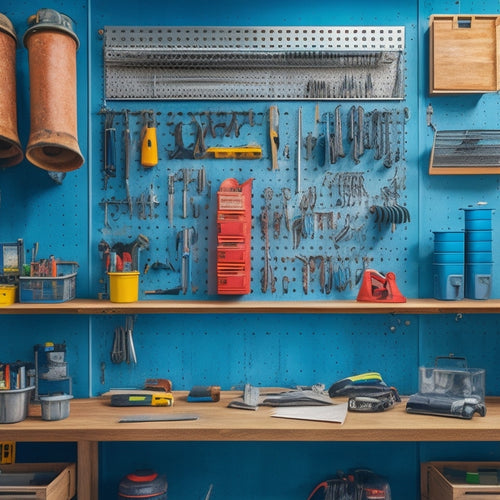
What's the Best Way to Store Tools in Small Spaces?
Share
When dealing with small spaces, you'll want to prioritize accessibility, flexibility, and space optimization to efficiently store your tools. Start by identifying your most frequently used tools and consider their size and shape for a customized layout design. Utilize modular storage units, label them for easy access, and prioritize needs based on your budget. Maximize vertical storage with racks, bins, and hooks, and opt for compact tool chests with adjustable dividers. By implementing these strategies, you'll be well on your way to a more organized workshop - and there are even more creative solutions waiting to be discovered.
Key Takeaways
• Utilize vertical storage solutions like racks, shelves, and pegboards to maximize small space storage capacity.
• Designate specific zones for frequently used tools and group similar tools together for easy access.
• Invest in compact and modular storage units like tool chests and shelving systems that can be customized to fit specific tools.
• Label and categorize tools to ensure quick identification and retrieval, saving time and energy.
• Optimize tool placement by arranging tools in task sequence order, minimizing movement within task areas, and ensuring essential tools are easily accessible.
Customized Tool Storage for Small Workshops
Maximizing the efficiency of your small workshop by implementing customized tool storage solutions that cater to your specific needs and available space is crucial. With a small budget, prioritizing your tool storage needs and creating a personalized layout that works for you is key.
Start by identifying the tools you use most frequently and allocating prime storage space for them. Consider the size and shape of each tool and design a layout that allows for easy access and minimal clutter.
Using modular storage units, such as pegboards or stackable bins, to create a flexible and adaptable system is highly recommended. These can be rearranged as your needs change, making them an excellent investment for a small workshop. Labeling each storage unit clearly, so you can quickly find what you need.
Maximize Vertical Storage Space
By making the most of your workshop's vertical space, you can greatly enhance storage capacity without sacrificing valuable floor space. This is especially important in small workshops where every inch counts.
To maximize vertical storage, consider installing vertical racks that can hold bins, baskets, or even tools themselves. These racks can be mounted on walls or placed in corners, making the most of often-wasted space.
Here are some additional strategies to help you maximize vertical storage:
-
Use shelf dividers to separate and organize tools and materials on shelves, keeping them easy to access and preventing clutter from building up.
-
Install hooks or pegboards on walls or ceilings to hang tools, accessories, or even bikes.
-
Invest in stackable storage containers or bins that can be labeled and easily accessed.
- Consider installing a mezzanine or loft storage area for infrequently used items, freeing up floor space for more essential tools and equipment.
Utilize Corner Tool Stations
Corner tool stations, strategically positioned to optimize the often-wasted space in workshop corners, can provide a dedicated area for frequently used tools and accessories. By incorporating a corner tool station into your workshop, you'll be able to efficiently store and access your tools, freeing up valuable floor space for other tasks.
When designing your corner tool station, consider the following key factors:
| Corner Design | Station Ergonomics |
|---|---|
| Curved or angled design to fit snugly into corner space | Adjustable height to accommodate users of different heights |
| Durable and sturdy construction to withstand heavy tool usage | Ergonomic handle design for easy grip and maneuverability |
| Customizable compartments and dividers for organized storage | Anti-fatigue matting for comfort during extended use |
| Easy-to-clean surfaces to prevent dirt and grime buildup | Integrated lighting for improved visibility |
| Modular design for easy expansion or reconfiguration | Integrated power outlets for convenient charging |
Optimize Cabinet Organization Systems
Frequently, cluttered cabinets can become a major obstacle in your workshop, but optimizing your cabinet organization system can transform these often-overlooked spaces into highly functional storage areas. By incorporating a well-thought-out cabinet design, you can maximize the storage capacity of your cabinets and make the most of your limited space.
Here are some strategies to help you optimize your cabinet organization system:
-
Assign a Home: Designate a specific place for each tool or supply to make sure that everything has a designated spot, making it easier to find what you need when you need it.
-
Shelf Allocation: Allocate shelves according to the frequency of use, with most frequently used items at eye level and less frequently used items on higher or lower shelves.
-
Use Vertical Space: Take advantage of the vertical space in your cabinets by using stackable containers or shelves to store less frequently used items.
- Label and Sign: Label each shelf and cabinet to help you quickly identify what's inside, and consider adding signs to indicate the contents of each cabinet.
Implement Pegboard Storage Solutions
When you're working with limited space, a pegboard storage solution can be a game-changer.
You'll want to start by brainstorming tool organization ideas that cater to your specific needs - think about the tools you use most frequently and how you can group them together.
Tool Organization Ideas
Optimize your workshop's functionality by implementing pegboard storage solutions, which enable you to hang tools within easy reach, freeing up valuable floor and shelf space. This is especially important when dealing with tool clutter, which can lead to wasted time and reduced productivity.
By creating a personalized system that caters to your specific needs, you'll be able to find what you need quickly and efficiently.
Here are some tool organization ideas to get you started:
-
Label and categorize: Organize your tools by type, frequency of use, or project-specific categories. Labels will help you quickly identify where each tool is stored.
-
Group similar tools together: Store tools with similar functions or uses together, making it easier to access what you need when you need it.
-
Use multiple pegboards: Consider installing multiple pegboards, each dedicated to a specific type of tool or project, to maximize storage and minimize clutter.
- Add a workstation: Incorporate a built-in workstation or countertop near your pegboard storage to create a dedicated area for working on projects.
Maximizing Wall Space
You can maximize the full potential of your workshop's walls by installing pegboard panels, which provide a customizable and space-efficient way to store tools, accessories, and supplies. These panels are easy to install, and you can hang them using wall anchors to make sure they're secure. With pegboard panels, you can hang items like hammers, screwdrivers, and wrenches, freeing up floor and bench space.
To make the most of your pegboard, consider adding magnetic strips to store small metal items like nuts, bolts, and screws. You can also use bins and baskets to store items like sandpaper, safety goggles, and other supplies. Label each bin and basket so you can quickly find what you need.
When deciding what to hang on your pegboard, think about the tools and supplies you use most frequently. Store them at eye level or near the top of the board for easy access. Less frequently used items can be stored towards the bottom or on higher shelves.
Create Tool Zones for Efficiency
To create tool zones for efficiency, you'll want to start by designating specific task areas within your small space. This means identifying the types of tasks you'll be performing most frequently and allocating a dedicated zone for each one.
Designate Task Areas
By grouping similar tools together in designated task areas, you create 'tool zones' that streamline your workflow and save time. This approach enables you to focus on specific tasks without wasting time searching for the right tools. To maximize efficiency, prioritize tasks and categorize tools accordingly.
For instance, you can create a zone for woodworking, another for metalworking, and so on. Within each zone, organize tools in a way that makes sense for the task at hand. Consider the following strategies to optimize your task areas:
-
Task Prioritization: Identify the most frequently used tools and place them in easy-to-reach locations.
-
Zone Signage: Label each zone clearly, so you can quickly identify where specific tools are stored.
-
Use vertical storage options, like pegboards or hooks, to maximize space and keep frequently used tools within reach.
- Consider investing in portable tool chests or carts to create mobile workstations that can be easily moved between zones.
Optimize Tool Placement
Within each designated task area, strategically place tools to minimize movement and maximize efficiency, ensuring the most essential tools are readily accessible. This is where creating tool zones for efficiency comes into play.
You want to establish a tool pattern that makes sense for your workflow. Think about the tasks you perform most frequently and group the necessary tools together. For example, if you're a woodworker, you might've a zone for measuring and marking, another for cutting, and another for sanding.
As you arrange your tools, consider the workspace flow. You want to create a smooth, logical path that allows you to move easily from one task to the next. This means placing tools in the order you'll use them, reducing the need to backtrack or search for what you need.
Streamline Workflow Paths
You'll create a seamless workflow by grouping tools into zones that mirror the sequence of tasks you perform, ensuring that each tool is exactly where you need it when you need it. This process is all about streamlining your workflow paths to maximize efficiency. By doing so, you'll save time and energy, allowing you to focus on the task at hand.
To create tool zones, start by mapping out your workflow process. Identify the tasks you perform regularly and the tools required for each task. Then, group these tools into zones based on the sequence of tasks. This will enable you to move efficiently from one task to the next without having to search for the necessary tools.
Here are some tips to keep in mind:
-
Analyze your workflow to identify areas of inefficiency
-
Use process mapping to visualize your workflow and identify opportunities for improvement
-
Group tools into zones based on the sequence of tasks
- Place frequently used tools in easy-to-reach locations
Choose Compact Tool Chests
Compact tool chests designed specifically for small spaces can be a game-changer, allowing you to store more tools in a fraction of the footprint.
When choosing a compact tool chest, consider the materials it's made of. Look for durable, rust-resistant materials like stainless steel or heavy-duty plastic. These will withstand the wear and tear of daily use and keep your tools protected.
You'll also want to think about space efficiency. Opt for a chest with adjustable dividers and compartments to maximize storage capacity. This will help you fit more tools in a smaller space. Some compact tool chests even come with removable trays or bins, making it easy to organize and access your tools.
When selecting a compact tool chest, measure the space where it'll go to secure a snug fit. Consider the height, width, and depth to get the most out of your storage space.
Designate Zones for Specific Tools
When you begin organizing your tools, it's crucial to designate zones for specific tools to maximize space and efficiency. You'll want to allocate tool stations, segregate tools by type, and designate work areas that cater to your specific needs.
Tool Station Allocation
Designate zones for specific tools by categorizing them into groups based on their frequency of use, size, and functionality to maximize storage efficiency in your small space. This approach allows you to create a tool station allocation that streamlines your workflow and saves time. By grouping similar tools together, you can create a logical flow of tools, making it easier to access and use them.
Here are some tips when allocating tool stations:
-
Prioritize frequently used tools: Place them in easy-to-reach locations to reduce walking distances and increase productivity.
-
Group similar tools together: Store tools with similar functions or uses in the same area to reduce confusion and improve tool flow.
-
Consider the size of your tools: Allocate larger tools to areas with more space, and reserve smaller areas for smaller tools.
- Design your station layout: Plan the layout of your tool station to minimize congestion and maximize accessibility.
Tool Type Segregation
You'll want to create separate zones for specific tool types, such as hand tools, power tools, and fasteners, to maintain organization and make it easier to find what you need when you need it. This is where tool categorization comes in – grouping similar tools together to simplify your workflow. By designating zones for specific tools, you'll reduce clutter and make the most of your small space.
Here's an example of how you can organize your tools:
| Tool Type | Zone | Example Tools |
|---|---|---|
| Hand Tools | Top Shelf | Pliers, screwdrivers, wrenches |
| Power Tools | Middle Shelf | Drill, saw, router |
| Fasteners | Bottom Shelf | Nails, screws, bolts |
Work Area Designation
Assign specific zones within your small space to distinct tool categories, ensuring each zone is tailored to the tools it will house. This work area designation approach helps maintain an organized and functional workspace, even in the most cramped of areas.
By designating specific zones, you can create a defined layout that streamlines your workflow and reduces clutter.
Here are some key considerations for implementing this approach:
-
Categorize tools by function: Group tools by their purpose, such as woodworking, metalworking, or electrical tools.
-
Consider tool size and frequency of use: Place frequently used tools in easy-to-access zones, and reserve less accessible areas for larger or less frequently used tools.
-
Establish flexible boundaries: Don't be afraid to adjust your zone designations as your tool collection evolves or your workflow changes.
- Label each zone: Clearly label each zone to help you and others quickly identify where specific tools are stored.
Invest in Modular Shelving Units
Modular shelving units are a great space-saving solution for small workshops or garages, allowing you to customize your storage space to fit your specific tool collection. You can choose from various configurations to maximize your available space, and many units come with adjustable height settings, so you can tailor the shelves to fit your tools and supplies.
One of the biggest advantages of modular shelving is its flexibility. As your tool collection grows or changes, you can easily add or remove shelves to accommodate your needs. This modular expansion allows you to adapt your storage space without having to replace the entire unit.
Additionally, many modular shelving units are designed with versatility in mind, offering a range of accessories like bins, baskets, and hooks to help keep your tools organized and within reach. By investing in a modular shelving unit, you'll be able to create a customized storage system that meets your unique needs and helps you stay organized and efficient in your small workshop or garage.
Consider Foldable Workstations
Foldable workstations can be a game-changer for small workshops or garages, providing a sturdy, flexible, and space-saving solution for various tasks and projects. You can easily set up and take down these workstations as needed, making them perfect for small spaces where versatility is key.
Here are some benefits of considering foldable workstations:
-
Portability: They're lightweight and easy to move around, allowing you to work in different areas of your workshop or garage.
-
Space-saving design: Foldable workstations can be easily stowed away when not in use, freeing up valuable space for other tools and equipment.
-
Customization: Many foldable workstations come with adjustable heights and angles, allowing you to tailor your workspace to your specific needs.
- Affordability: Foldable workstations are often more budget-friendly than traditional workbenches, making them a great option for DIYers and hobbyists.
Frequently Asked Questions
How Do I Keep Frequently Used Tools Easily Accessible?
You'll want to keep frequently used tools within easy reach by organizing them on tool trays or pegboard organizers mounted at a comfortable height, ensuring you can quickly grab what you need without wasting time searching.
Can I Store Tools in a Humid or Wet Environment?
"You've seen it happen: tools rusting away in a damp garage. To avoid this, you can store tools in a humid environment, but be sure to use a dehumidifier or waterproof containers to keep them dry."
Are There Any Tool Storage Solutions for Irregularly Shaped Tools?
You'll love that custom inserts and adaptive holders are designed specifically for irregularly shaped tools, allowing you to secure them snugly, keeping them organized and within easy reach, without wasting precious space.
How Do I Prevent Tool Rust and Corrosion in Storage?
Remember that rusty old bike you left outside last winter? Don't let that happen to your tools! You prevent rust and corrosion by using rust inhibitors, like silicone sprays or wax, and maintaining climate control in your storage space.
Can I Repurpose Household Items for DIY Tool Storage?
You can repurpose household items for DIY tool storage by using a pegboard hack to hang frequently used tools, and Mason jars to store small parts and screws, keeping them organized and within reach.
Related Posts
-

Adjustable Modular Shoe Racks for Versatility
Adjustable modular shoe racks are your go-to solution for versatile and organized footwear storage. These racks maxim...
-

Storage Bins for Shelves to Keep Clutter at Bay
You're looking for a way to keep your shelves organized and clutter-free, and storage bins are the perfect solution t...
-

Custom Pegboard Storage for Your Workshop
You're looking to create a custom pegboard storage system that maximizes your workshop's space, enhances productivity...


